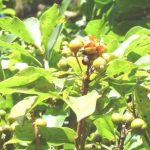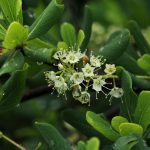TREE LIFE
SEPTEMBER 1993
MASHONALANID CALENDAR
Tuesday 7th September : Springtime again and there will be stirrings in the Botanic Garden. Park at the Herbarium where we will meet Tom Muller at 1645 hours 1500 hours for our walk.
Sunday 19th September : It has become tradition to be in the Marondera area for our September outing where the Msasa trees are usually brilliant in their spring colours. Mr and Mrs Christopher Bell of Elmwood Farm have kindly invited us for the day.
Saturday 25th September: Botanic Interest Walk. Please phone Mark to confirm venue and time. The Hyde family is on tour at the moment but nearer the date. Mark can be contacted at home on 701025 or at the office on 793601.
Tuesday 5th October : Botanic Garden Walk.
MATABELELAND CALENDAR
Sunday 5th September : To ‘Imadzi and Guleti for a morning walk in the Matopos. It will be an 80 Km trip all told. Bring a portable tea, and we hope you will be back home for lunch or perhaps you would like to picnic-in the Matopos. Meet at Girl’s College for an 0830 hour departure.
Monday 13th September : Urban Trails, Hillside Dams at 1645 hours for 1700 hours.
Sunday 3rd October: The worst of the leafless months so we have arranged a talk at Mabukuweni. June Davis has very kindly agreed to tell us about natural dyes.
Monday 11th October : Urban Trails
Sunday 7th November : An Acacia School (Part I) at Glengarry.
SEEING RED :
Frequently when we go but on our trips in the summer, but particularly the spring months, we see trees flaunting the new red flushes of leaves. It’s a phenomenon I have always pondered upon. Thus it was with much interest that I read recently an article published in BBC Wildlife, a British journal. An Oxford University Plant Scientist, Dr. Barrie Juniper, has suggested that those red flushes are a means of insect evasion. The flush leaves develop very rapidly and lack the normal chemistry and structure of the mature leaves. Thus, they hang limply like “a piece of wet tissue paper” as they grow to their correct size, whereupon with equal speed they green, strengthen and become rigid. These new leaves are an investment by the plant of nutrients for which, until the leaf is fully grown, there is little return in the form of photosynthesis. At the same time, however, such new growth is attractive to insects who would rob the tree by consumption of the new growth. The solution then is to expand rapidly not, to an insect, appear as edible leafy material. “If you do not look like a leaf (to an insect’s limited vision), if you do not feel like a leaf, because you are soggy, if you do not have the posture of a leaf, because you are hanging down like wet blotting paper, if you do not smell like a leaf, because you do not photosynthesis, and if on the first bite or suck you do not taste like a leaf, because you contain no sugars (produced by photosynthesis), then the chances are you’ll escape being “eaten”. Once achieving the correct size, leaves begin to photosynthesise for themselves, thus they go green and develop their usual character. Trees are then able to tolerate a degree of nutrient loss due to leaf consumption, while others develop new tactics such as spines, silica, tannin or toxin content. The leaf’s own photosynthesis enables these additional features to develop, it does not draw on the nutrient reserves of the tree itself.
Dr. Juniper then notes that there is a great variety in terms of colouring of these new flushes, even of the sane species, but unfortunately he doesn’t know why this is so. I remember our discussing this at the Great Dyke some time ago, where on a Tree Society trip we saw a wonderful variety of Brachysgtegia boehmii flushes. Are some plants more concerned about insect attack than others, or is it genetic variation? Comments required. One thing I find attractive in this hypothesis, is its ability to account for the occasional tree we find in its red flushes long after the others have greened. I am particularly thinking of the few odd specimens we encountered on the Berger‘s farm, east of Harare (Jan. 93). Dr. Juniper suggests that should there have been a massive insect predation, the trees are losing photosynthesis potential which will fall until reaching a critical level, where upon the tree defoliates and begins again with new red flushes to the disinterest of these same insects which, hopefully, will have gone off elsewhere. Next time I will have to check these odd trees. Interestingly, the malformed leaves at Lake Chivero (after the weed spraying last year) turned green and did not abort. Obviously there hasn’t been a photo- synthesis loss due to consumption, they just don’t look nice to us. Anyway this is just a new idea I thought worthy of sharing.
-Rob Burrett
SOME THOUGHTS ABOUT HISTORIC TREES IN MATABELELAND
There are, by our count at least ten trees in and around Bulawayo which are of historical interest and without wishing to be provocative; sentimental of chauvinistic, we do find this a singularly rich occurrence. One does, of course, know of significant trees elsewhere – the “Big Tree of Victoria Falls”, the “Big Tree of Masuna” and not forgetting, the “Big Tree of Kadoma.” (now known as the “Crochet Tablecloth Tree”). Is English not a superbly descriptive language? But seriously, what about trees linked to the big names of Zimbabwe’s post — to Mzilikazi, to Moffat, to Johnstone, to Lobengula, to Forbes, to Baden Powell and so on? Is there an assemblage quite like this in any other part of the land?
Perhaps the country in and around Bulawayo has much to do with it. The ancient highveld plateau of Southern Matabeleland has been smoothed by time and the elements over 100 millions of years into a rolling and rather featureless plain. In the fifty or so years before the Matabele War the Abazani, the People from the South, and their conquered followers moved into and settled across this countryside. The names of their capitals, towns and regimental settlements are still with us —- Mhlahlandhlela, Gubuluwayo, Umvutcha, Inyati, Tshabalala. They, of course, varied in size, and whilst Isogodini, Mzilikazi’s private kraal was probably rather small, Lobengula’s Bulawayo on the hill of Umhlabatini housed ten thousand people. Royal feasts, defensive stockades, building materials, domestic utensils and daily fuel needs ensured a fairly swift depletion of local wood resources and their ultimate exhaustion after a dozen or so years forced the community to move on.
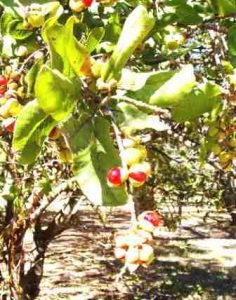
Pappea capensis. Photo: Mark Hyde. Source: Flora of Zimbabwe
But the nineteenth century Hdebele were not indiscriminate hackers. In and around Bulawayo they found trees which they had known and valued in their native Zululand. Umncaga (Berchemia zeheri) was reserved for the king’s regalia, his throne, pillow, stool, kerrie and ceremonial assegai. Two such trees, ancient and beautiful still stand, one on Lady Stanley Avenue and one on Lawley Road. Umgqogqo (Pappea capensis) featured prominently in Ndebele pharmacology and umkandu (Lonchocarpus capassa) had spiritual and magical properties. Sclerocarya birea, Teminalia sericea, Ziziphus mucronata and Pterocarpus had fairly specialised uses and these as well as others would have been rather carefully husbanded. Some, and here one immediately thinks of Combretum imberbe (not known in Zululand), would almost defy exploitation. Weighing in at 77 lbs per cubic foot, hard, tough and loaded with silica it was more than a match for iron age cutting technology.
What the vegetation of the Southern Matabeleland highveld might have looked like prior to 1838 is open to conjecture, but photographs of the 1890s give a very clear idea of what fifty years of Ndebele settlement had wrought. Pictures of Hope Fountain, Fort Khami and Fort Grainger show grassland with scattered trees and some of these are majestic and mature specimens, quite deliberately, for one reason or another spared from the woodsman’s axe.
It is therefore not really very surprising that in this featureless terrain of low relief, clothed in a vegetation rather specially modified by the Ndebele that a few large and handsome trees should take on a particular significance. Since some of them would in fact be taller than elements of local relief, trees would assume importance as both landmarks and beacons, such as “Two Tree Kop” and the “Figtree” of old Figtree (Lobengula‘s immigration post). Others fulfilling a similar sort or role would be the “Flag Tree” and the “Look-Out Tree”. They would also provide rendezvous points and because of shade, comfortable places of assembly. The obvious examples are the various Indaba trees and is it merely coincidence the two of Lobengula’s Indaba trees were Papea capensis? Shelter was not only considered important for the king and his court, but for visitors too. They were given special camp sites, which were frequently dominated by large shady trees. Such as the Missionary Tree at Umvutcha which gave, at separate times, a temporary home to John Moffat, Rudd, Thomson and Macquire and others. It also became Zimbabwe’s first post office when in its shade Moffat cancelled Bechuanaland Protectorate stamps with the mark Gubuluwayo and sent them south by runner to Mafeking. Today these are collectors items.
Unpleasantly too, trees have become places of punishment. Two in Bulawayo have served as gallows and when Lobenguls finally lost his temper with Boggie (of Gwelo Tower fame) , describing his behaviour as that of an annoying puppy yapping at the royal ankles, he appropriately punished the man by chaining him, dog-like, to the Missionary Tree. The resourceful Boggie whiled away his captive hours by carving his name on the tree (he must have ruined the knife) and letters “0” and “G” can still be seen today.
Some of the historic trees of Bulawayo are proclaimed monuments; others are not and perhaps should be. But I would like to think, that in a metaphysical sense they are so very different from man-made monuments. The latter take on qualities and are tainted by the philosophy of their builders. They are created as premeditated and frequently boastful acts of man and this is why men pull down statues when human idols have fallen. But trees are only monuments because by chance they have stood in the path of history and because they predate the events which pass them are there fore ever innocent, ever impartial and never vainglorious. They are not destined for immortality and because they will one day die it seem even more wanton to destroy them because of a chance meeting with history. I am happy to report that most, if not all, the five historic trees we saw on Sunday 1 August still live.
-Lyn Mullin
TREE OUTINGS WITH A DIFFERENCE – FIFTY YEARS AGO
I count myself very fortunate to have had the gratifying experience fifty years ago of planting quite a lot or the present lovely Vienna Woods and keeping them tidy. It all started at “Knightsbridge”, June 6, 1942 – not the London version, but the misnomer south of Tobruk on the Western Desert. The only traffic in sight was our transport receding in the distance after dropping us in the seemingly middle of nowhere. Albeit not for long as dozens of Rommels tanks emerged to challenge our 303Lee Fieldds. An uneven-contest. We met that gentleman a few days later.
Spent the next year in Italy at various “holiday camps” of six thousand souls going further north with each move. – Rommel pulled out of North African and, deciding that Italy wasn’t worth defending, picked us up on his way through the Brenner Pass to the Fatherland, eventually finding our way into that wonderful country, Austria.
Prior to that, we were divided into small working parties. At Kaisersteinbruk on the Hungarian Border I was drafted into a party of a couple of dozen. From there to Allensteig near Vienna, (discovered this years later), where we learned the rudiments of a Woodsman’s craft. Then shipped or rather trucked (driven by steam as we fed the boiler behind the cab with logs) to the lovely village of Ottenstein where the working site was on the banks of Hitler’s River Kanpf (his struggle) where our 25 litre keg of beer cooled in the turbulent waters. Fairytale castles looked down from almost the heavens.
Another working site saw us walking through the town of Bern, Hitlers birthplace, and past the very house in which he was born. A further change of scenery took us to Pertenshlag near the bustling town of Arbesbach where a doctor could be found it needed.
The work consisted of clearing huge tracts of trees damaged by storm and gales, also pulling down the trees designated by the Austrian woodsmen. Some were a metre in diameter being 130 years old. Two weeks of lumberjacking would be followed by a week of planting saplings in the newly stumped areas. The young trees we collected from a Baum Schule. Beech, (Fagus sylvatica), Pine (Pinus sylvestris) and Ash (Fraxiuos excelsior) were planted, the last named being straight – were ideal for the axe handles we used.
Weekends were spent playing soccer or cricket (thanks to Red Cross issue). Once an all day cuting to another camp 25 miles away for a one-all draw. Afterwards entertainment in the village local with Frauleins handing round the beer in those lovely mugs – the steins, and one playing a piano accordion – Roll out the Barrel and other popular Sing Song tunes.
Apart from being locked up at night, these ‘Holiday Camps‘ were a great improvement or those south of the Brenner.
Thora and I have visited Austria three times since ’83 – must have seen some of my Fifty year old trees.
-Ken Hartley
ASHLYNS FARM – WEDZA 11TH – 15TH AUGUST 1993
Bad luck Mahammed (Tree Life July 1993) your fellow ‘dendrophiles’ accepted your challenge and their total for the surrounds of the lodge was 75 species including several Rhannus staddo.
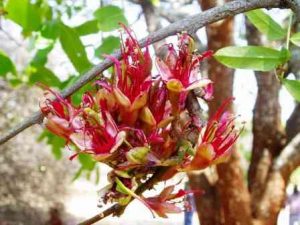
Schotia brachypetala. Photo: Mark Hyde. Source: Flora of Zimbabwe
On Thursday morning we headed off through the game area, the cars suspension being thoroughly tested on several humps in the road. The first stopping place was next to a thicket on an anthill containing a large Schotia brachypetala in flower the winged rachis of the leaf being most distinctive. Our movements disturbed several kudu cows who flitted past on the other side of the stream, their ears flickering to gauge our position.
Driving on again this time to a riverine area, near a massive granite dwala known as Mtemwa mountain, where we stopped next to a low level bridge. Linda and the children headed back up the road to climb Mtemwa leaving the rest of us to ‘fossick’ as we pleased. A sweet scent in the air was quickly identified as belonging to a clump of flowering Acokanthera oppositifolia literally dripping with white blossom!
After adding the usual highveld species to the card we wandered along the path at the base of the dwala to see some cave paintings. However, behind a split boulder an obese grey Ficus glumosa oozed out of crack and spread itself on the rock face presenting an interesting combination of shapes and colour in the afternoon sun.
A nearby tree with a very white peeling bark and orange coloured leaves was identified as a Heteropyxis dehniae . An interesting feature we found was the strong smell of camphor/lavendar when the leaves were crushed — did wanders for the sinuses!
With Mark’s collecting bag filling rapidly and a card showing 87 ticks we decided to call it a day and headed back to the lodge, the days collection requiring pressing before dark. The exciting find of today be Fagaropsis angolensis. We were able see the glands the along the leaf edges, and get the strong RUTACEAE smell from the crushed leaves.
Friday dawned very cold and wet, the mud having whipped up the rain which in turn had done its best to irrigate Maureen’s tent! Needless to say no one was exactly enthusiastic about botanizing on Wedza mountain in these conditions but weather prophet Fiona said it would clear by 11 a.m. (and it did!) The mountain was covered in mist when we arrived and after some 4 W.D. antics we approached the summit. The icy air, poor road and stunted Brachystegia woodland convinced us that some interesting riverine woodland further back was worth a look. This was an interesting area and with windcheaters (courtesy of the Hamilton’s) we were able to find a flowering Sericanthe sp., some Fagaropsis angolensis and an unusual Rhuss with small bright green serrated leaflets — another query for the herbarium.
After some HOT TEA we embussed and drove to the extinct workings lower down Wedza Mountain. Near to our lunch spot an incredibly deep hole was noticed so Andrew and Robert Hyde were encouraged to stray near the Landcruiser. Behind the remains of a building the scars of mining were still visible as an enormous cavern with two shafts had been out into the side of the hill. Some tall, droopy leaved Trema orientalis and a leafless Lannea discolor found these old workings a suitable home. In the damper parts, Mark showed Rhoicissus tomentos a vigorous climber with an enormous single leaf. So very different from the other highveld relatives. From the hillside above the defunct workings we had a view of the plain below with the sandy Sabi River snaking its way southwest past the Mtukwa Hills.
Some interesting species which we did manage to identify today were Protea petiolaris, Choristylis rhamnoides with pinched veins many Dioopyros whyteana, many Dombeya burgessias laden with the brown remains of a very prolific flowering, Ilex mitis, Olinia vanguerioldes whose leaves were mostly a sort of liver red, Vermonia myriantha was draped over and climbing onto strong supports were flowering Podranea brycei, the Zimbabwe creeper Mussaenda arcuata related to the flag bush in our gardens and the very thorny Tuddalia asiatica whose fruit resembles a marble sized naartjie.
Back at Ashlyns farm the Hamiltons suggested that for the next trip an area known as Ruzawi falls might be interesting.
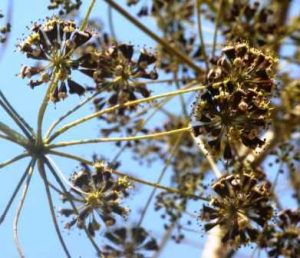
Steganotaena araliacea . Photo: Bart Wursten. Source: Flora of Zimbabwe
So on the Saturday we drove down to Ruzawi Falls, the. altitude, of +- 1000m being much more friendly than the cold Highveld. Much jolting along rutted tracks brought us to a clearing where we parked, had TEA and followed the path to the Falls.
Amongst the 100 species recognised today several Olax dissitifolia gave the opportunity to enjoy the ‘Snap‘ sound when breaking a leaf in two and also to sample the almond smell after crushing the leaf. Purple flowering Steganotaena araliacea looking like an outsize parsley flower were dotted about in the very dry bush more suited to the likes of Commiphora mollis and Maytenis heteroplylla. Shouts of glee further along indicated that Linda and the children had reached the waterfall. The rest of the party ambled up a few minutes later to a spot just below the rock face where the Ruzawi river cascaded over the ledge and into the deep pool below. It was quite a surprise to see such large Dalbergia melanoxylong growing in the rocky confines of the river course. Unfortunately the wood cutters had been there before us as several massive trunks had been felled.
After a short stop on the opposite bank for a bite to eat we slogged up a steep track to approach the waterfall from behind. Mark’s interest was rapidly increased as just above the falls an Acacia nigrescens came into view (a first recording in the central division). This dry area was also host to A.goetzii subep. Microphylla and Eggorbia matnbelicm. Crossing the river by way of some large flat rocks we struggled up the opposite bank meeting head on with several clumps of E.grisecla – ouch!! From this rocky ledge the view was superb with splashes of orange from Aloe excelsa in the Brachystegia woodland, the waterfall and the now distant rocky course of the river.
It was unfortunate1y time to leave and after prolonging things as long as possible with “finds” of Artobotrys brachypetala with its unusual curled flower stalks, we headed back to town under cover of darkness.
Very many thanks to Mark and Linda for organising this most interesting trip and despite the cold we had a really enjoyable time.
We achieved something too, having marked cards for 4 QDS’s.
-Andy Nacnaughtan
CAESAR PASS – 15 AUGUST 1993
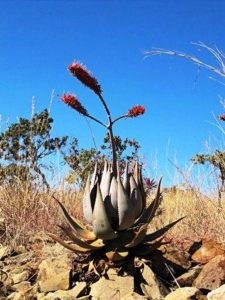
Aloe ortholopha. Photo: Ilsa Grundy. Source: Flora of Zimbabwe
Tea and cakes greeted us on our arrival at Barwick Club, most welcome on a cold morning in hilly countryside. After assembling, the convoy of vehicles headed off past Caesar Mine and down into the cutting, the swirling dust almost obscuring the last orange flowers of nearby Aloe ortholopha.
A well wooded area partly obscured a turning to the right and from here we walked alongside the gurgling stream. The riverine bush at this stage was dominated by Nuxia oppositifolia (in bud), wavy “leafed” Euclea divinorum and Myrica serrata with golden tinge to its leaves. Evidently the children had primed each other with the various tree names (from the last issue of Tree Life) as squeals of excitement were uttered on finding an Ozoroa longipetiolata.
The sun having vanished behind a cloud bank some ten minutes earlier reappeared and in so doing rekindled interest and we followed a well worn path past some Vangeriainfausta, standing stark against the rocks with only a few leaves as a guide. The path then decended to the stream past a cluster of Bequaertiodendron magalismontanum (stem fruit) a few pinkish buds being visible on the stems. Some nearby Phoenix reclinata whispered to themselves in the breeze but being a cold damp spot we moved on to a sunny area between a kopje and the river bank. Here, on its own a Pavetta schumanniana displayed the black bacterial nodules in its dry leaves. According to research done on the nodules they are essential for the plants growth, remove them and the growth rate drops to nil! More familiar woodland came into view with Brachystegia glaucescens and a B .boehmii giving some comfort to those suffering from arboreal overload. Securidaca longipedunculata added some variety and a Olax obtusifolia created interest as several members enjoyed the satisfying “crack” as they snapped a few leaves in half. Some excitement nearby from Kenneth Haxen‘s scorpion group indicated that they had found and caught one of these creatures!
An early return to the cars via the back of the kopje brought other familiar species into view this time a fruiting Bauhinia petersiana a graceful Faurea saligna. However, the desire for warmth and food meant that the few Osyris lanceolata were passed by with little interest.
The afternoon walk started on the dry roadside bush and headed towards the lower stretches of the stream. In the drier section Maytenus heterophylla mingled with its relative M.undata but the combination of waxy, dusty leaves and needle sharp spines was not good for exploring fingers. Several large Pterocarpus angolensis and one Ilex mitis were noted near the stream bank and after investigating some Rapanea melanophloeos cries of anguish from Jemima who had tangled with a Pterolobium stellatum made us wonder ii the name :51‘ the plant should be Terror-lobium. Fortunately, Maureen was in the vicinity and ointment mixed with sympathy was applied. After this Fiona found a Tarenna neurophylla and we puzzled over the “neuro” part – surely not a nervous leaf.
A short walk to the road and there we paused to look at some Euphorbia wildii, the strange trunk looking somewhat like a stretched pineapple with feathery leaves on top.
Arriving back at the vehicles ended a most enjoyable Dyke outing and we would like to thank Rod Petzer and the ladies who gave us tea and eats very much indeed for organising the club for us.
-Andy Macnaughtan
BABOON DAMAGE IN PINE FOREST ESTATES
The Chacma baboon Papio ursinus, by its bark-stripping habits, has become a serious pest in Zimbabwe’s pine plantations, of economic importance second only to losses from fire. A study of the extent and characteristics of damage by baboons has recently been carried out. Some features of the damage are briefly reported upon here.
Although baboons have been a menace to agricultural crops, they have for years not been as destructive in plantation forestry. Occasional, badly damaged trees couldbe taken out during silvicultural thinning. But the incidence of damage in recent times has gone beyong 50% and more than 205 of the trees are already dead in some compartments in the four most affected estate around Chimanimani. The total amount of loss is estimated at several million dollars.
The increase in damage is mainly associated with the large baboon populations and the 1991/92 drought, which left the baboons with almost nothing to ear. Once a troop becomes skilled in the practice of bark-stripping, there is a tendency for such behavious to become so habitually established that it may not stop completely even in times of food abundance.
Nature and extent of the damage : Baboons cut and loosen bark with their teeth and then tear off strips with their fingers. The bark should not be too thick and coarse which is probably why small to medium size trees suffer the most damage. Bark-stripping is mostly concentrated in a zone between two thirds and three quarters of the tree height. After the bark is removed, the baboon either just licks or uses its incisor teeth to scrape off and then swallows the thin layer of cambial tissue. Strips of scraped bark are often left littered beneath damaged trees. Baboons prefer to strip the bark in an upward direction and the trees are either damaged on one side or completely ring barked. Since 1991 there has been an increase in cases of complete ring barking, resulting in losses of crowns or deaths of whole trees.
Damaged areas have been estimated per estate, for trees in 4-16 year age groups. The planted area in the central part of the district totals 31 334 ha, of which 3 743 ha. is already effected. Baboon damage has also been seen in stands of between 17 and 35 years, but they are isolated cases causing little economic loss. In research trials, tree improvement programmes have been interfered with when the best trees are damaged. Low-lying areas that are isolated and compartments along streams and those near roosting places are among the worst affected.
Damage is not only spreading fast to new areas but is also being intensified within the already affected ones. Previously damaged trees are being revisited and new species are being experimented with, while bark-stripping experience appears to be rapidly increasing among various troops. It is feared that a further 700 ha will be effected by the end of 1993 while some or the already affected compartments will be totally lost by the end of 1994 if the present rate of damage continues unabated.
The few forest estates have not been affected owing to the species planted, the amount of food available and the fact that troops patronizing such areas are not yet aware of the sweet taste of pine cambial tissues. Places adjacent to communal areas are little affected, very probably because of greater interference from people and dogs.
SPECIES DAMAGED. Damaged trees in the most seriously affected blocks average 85% Pinus taeda, 48% P. ellicttii and 27% for P.patula. P.elliottii is mostly affected when P.taeda is not planted nearby and in altitudes below 1 000m where it is the dominant species. The presence of P.taeda appears to prevent other species in an area from being attacked.
P.patula has a a thinner bark and is more strippable but it is rarely attacked by baboons, probably because of a strong aroma peculiar to this pine, which is not as sweet as that of the other two species. Baboons seem to be damaging trees for no greater reason than taste. P.patula has a few cases of damage by eland, Tauretragus oryx and the study has shown that a number of foresters have been confusing eland damage with baboon damage. Eland strip bark by mouth while the animals are standing on the ground, so their damage is generally confined to the area of trunks and complete ring barking is most unusual.
Other species in plantations and research trials, P.kesiya, P.cocarpa and P.maximinoi have been only slightly affected. One P.chiapensis breeding seedling orchard has been seriously damaged to the extent of 80%.
No damage had previously been recorded in gum plantations, but recently there have been confirmed reports of Eucalyptus maculate and E.microcorys being affected in some compartments. Baboons feed on the seeds of black wattle, Acacia mearnsii, but they do not strip wattle bark.
-H.C. Nhongweh From Format June 1993, acknowledged with thanks to author and publisher.
We bid a very fond farewell to Patrick and Fionna Dawe who return to England on 31st August. We picture them delving eagerly into the flora of the Northern Hemisphere and hope to read about their exploits one day in Tree Life. Thank you Pat and Fiona for your enthusiastic participation in the activities of the Tree Society during your stay in Zimbabwe.
ANDY MACNAUGHTAN


